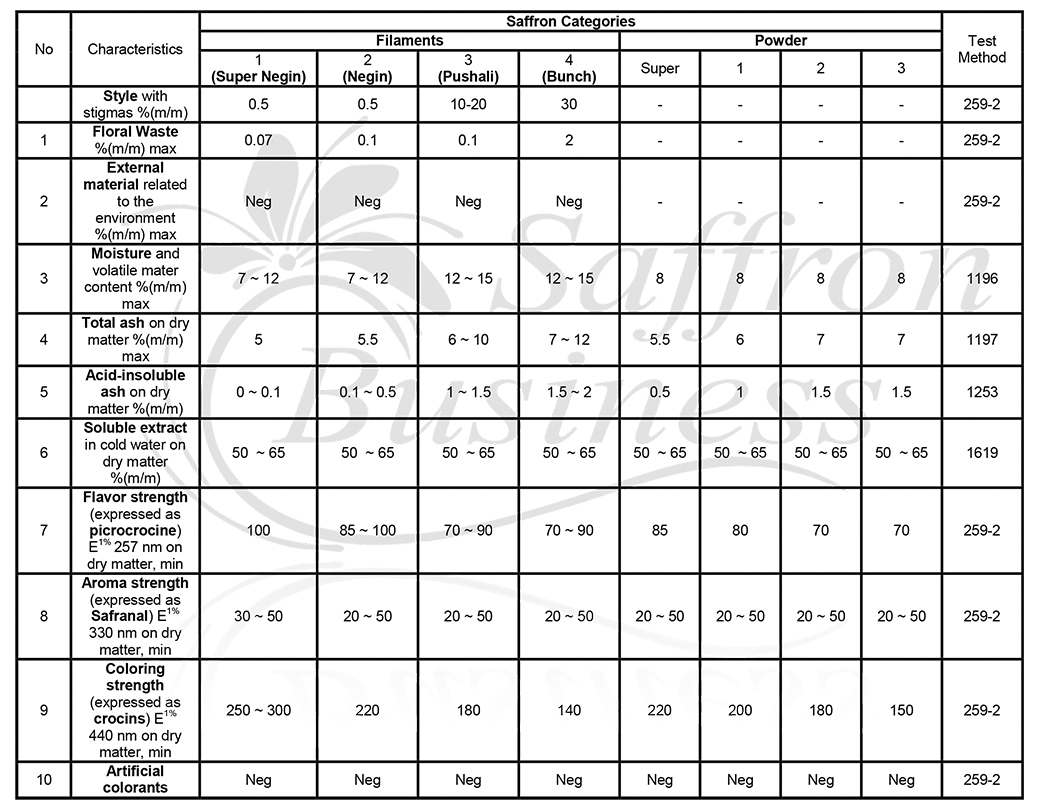Saffron is the kind of spice that adds color, taste and aroma to various foods. Thus we could say that the best saffron is the one with high quality color, taste and aroma features. Regarding taste, the responsible substance is picrocrocin. Whereas color is provided by dye substances, the crocetin esters that belong to the carotene group. Safranal is a volatile substance contained at high amount in the saffron spice. Saffron quality is determined in our lab after testing a series of characteristic parameters in the spice itself (endogenous parameters) combined with necessary external or exogenous conditions (exogenous parameters). Physical and chemical parameters such as humidity, flower residue or foreign material are considered exogenous while others like ashes content, soluble condensate, coloring power etc. are considered to be endogenous parameters.
In this table you can find a sample of our analysis for different grades of saffron available.

Adulterations and Lab Methods to Find Them Out
Due to its high value, saffron has been subjected to many adulterations throughout history. While, more than any other spice, it should be free of any kind of adulteration, namely “metallic” substances such as oils or molasses that increase its weight or possible additive dyes to fictitiously improve its appearance.
Three different methods are used for detecting adulterations: Thin layer chromatography (TLC), high pressure liquid chromatography (HPLC) and microscopic analysis.
Thin layer chromatography has an average cost and is used for bacterial analysis even on large samples. If adulterations are detected by the TLC method, positive characteristics are detected trough high pressure liquid chromatography (HPLC) which is a more sensitive detection technique. Nowadays, the ISO/TS 3632,2003 recommends the use of this method for identifying saffron dye substances as well as for identifying acid water-soluble dye substances.
The HPLC method is used for the determination of three different elements:
• Identification of dye substances responsible for saffron’s coloring intensity (crocines),
• Identification through artificial dye substances, water-soluble acid, pursuant to the ISO/TS 3632, 2003,
• Identification through fat-soluble dye substances.
Although The European Union has not yet specified the maximum limits regarding pesticide residue in spices, the Spanish law has established the HAR regulation (Highest Acceptable Residue) for a series of 430 pesticides in spices, in accordance with the unified law of April 2005. Fungicides and insecticides are among the defined pesticides with maximum limits varying from 0,01 mg/kg buprofezin to 400 mg/kg of inorganic bromide. Pesticide analysis takes place by applying the method of gas chromatography (GC) and preferably through mass spectrometry detection.
The microbiological method is not described in detail in the ISO/TS 3623,2003. The Spanish legislation is based on the Technical Health Regulation (RTS) for spice treatment, distribution and marketing because
no specified standards exist for saffron spices. According to the RTS, the existing limits of pathogenic microorganisms and their toxins should be below following highest limits:
• Escherichia coli (1 x 101 col/g)
• Salmonella (absence of 25g)
• Sulfite reducing clostridia: seed production under anaerobic conditions (1 x 103 col/g).
The microbiological methods applied on Greek saffron for microbiologic load determination as well as for detecting ferment and coliform organisms (Escherichia coli) are defined by the ISO 4833, ISO 7954 and ISO 16649-2 respectively. One sample gram is being homogenized and separated in decimal solutions in order to tally the microorganisms that could be eventually present.